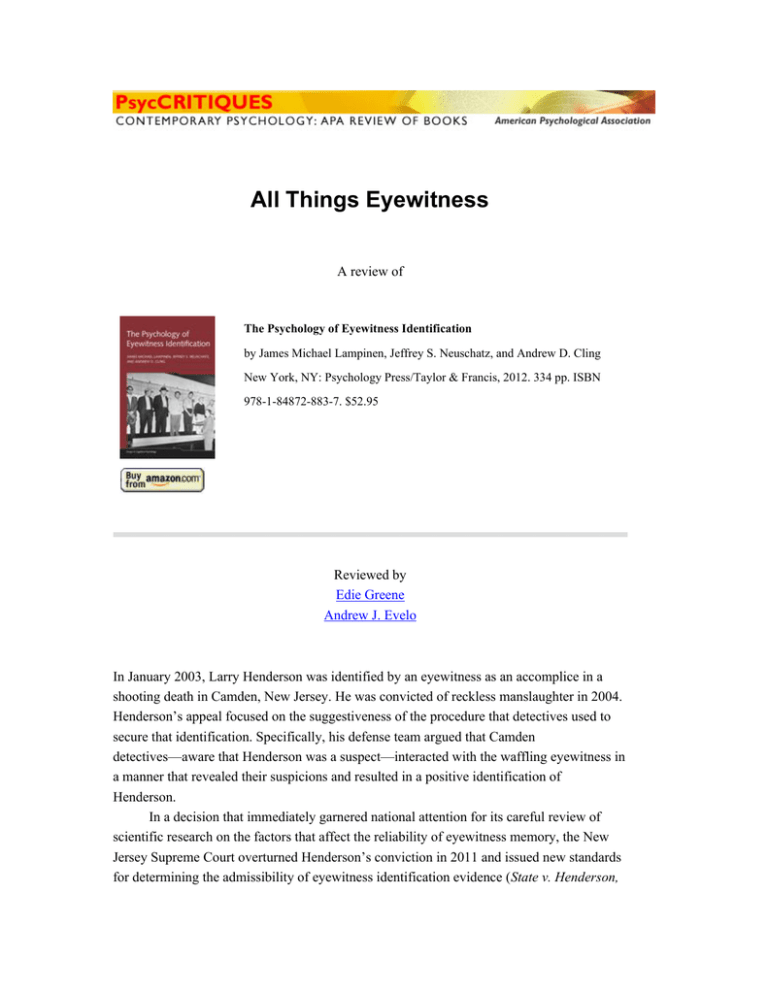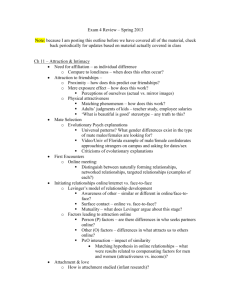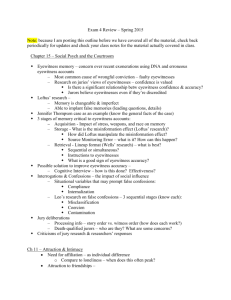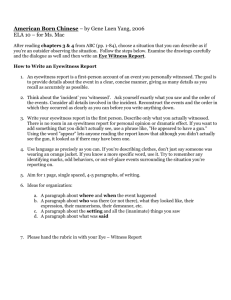All Things Eyewitness A review of
advertisement

All Things Eyewitness A review of The Psychology of Eyewitness Identification by James Michael Lampinen, Jeffrey S. Neuschatz, and Andrew D. Cling New York, NY: Psychology Press/Taylor & Francis, 2012. 334 pp. ISBN 978-1-84872-883-7. $52.95 Reviewed by Edie Greene Andrew J. Evelo In January 2003, Larry Henderson was identified by an eyewitness as an accomplice in a shooting death in Camden, New Jersey. He was convicted of reckless manslaughter in 2004. Henderson’s appeal focused on the suggestiveness of the procedure that detectives used to secure that identification. Specifically, his defense team argued that Camden detectives—aware that Henderson was a suspect—interacted with the waffling eyewitness in a manner that revealed their suspicions and resulted in a positive identification of Henderson. In a decision that immediately garnered national attention for its careful review of scientific research on the factors that affect the reliability of eyewitness memory, the New Jersey Supreme Court overturned Henderson’s conviction in 2011 and issued new standards for determining the admissibility of eyewitness identification evidence (State v. Henderson, 2011). Judges in New Jersey must now scrutinize police procedures to assess the risk of misidentification. Among the factors they are to consider are the following: whether the lineup was administered in a “double-blind” fashion, meaning that the administrator did not know the identity of the suspect; whether the eyewitness was instructed that the perpetrator may or may not be in the lineup; whether the police provided any feedback that could have affected the eyewitness’s choice; and whether the eyewitness had viewed the suspect in prior identification procedures. All of these concepts have been formulated and tested by psychological scientists. When they do admit eyewitness identification evidence, judges must now provide detailed instructions to the jury, informing them of the factors that, according to psychological research studies, can result in misidentification. Legal observers expect that courts across the country will follow New Jersey’s lead. Ironically, the case of State v. Henderson (2011) is not included in the excellent new book on eyewitness memory, The Psychology of Eyewitness Identification, by James Lampinen, Jeffrey Neuschatz, and Andrew Cling, undoubtedly because it had not been decided when the book went to press. And although the New Jersey Supreme Court was guided by findings of a special master who conducted hearings with research psychologists and reviewed the exhaustive literature on eyewitness memory, it could just as easily have relied on this comprehensive, accessible, and current treatise on “all things eyewitness.” Other authors cover some of the same territory (e.g., Cutler & Kovera, 2010; Lindsay, Ross, Toglia, & Read, 2007; Sporer, Malpass, & Koehnken, 1996). None do so as thoroughly as Lampinen, Neuschatz, and Cling. The book begins with a highly useful chapter on theoretical approaches to eyewitness identification that will serve as a refresher for some readers and as important foundational material for others. The authors refer to those theories in subsequent chapters as they describe and synthesize a vast body of classic and recent research on psychological factors in eyewitness memory. They organize these studies using the structure developed by prominent researcher Gary Wells and familiar to eyewitness investigators, namely, distinguishing estimator variables (e.g., arousal and stress, passage of time, own race bias), system variables (e.g., cognitive interview, exposure to mug shots, composition of the lineup), and postidentification indicia of reliability (e.g., eyewitness confidence). The authors include a chapter in which they focus on field studies of eyewitness identification and compare findings from those studies with results gleaned from laboratorybased research. This analysis—showing that, for the most part, results of laboratory studies are consistent with findings from field studies—will be much appreciated by psychologists who testify as eyewitness experts and who must address prosecutors’ criticisms that studies conducted in controlled laboratory settings cannot be applied to real eyewitnesses and real crimes. Lampinen and his colleagues have done those psychologists a favor by carefully and competently analyzing, synthesizing, and comparing results that come from these varied methodologies. This volume also covers topics that other authors either skim over or bypass altogether. The authors provide details of how identifications are affected by visual perception associated with illumination and distance, fluctuations in memory as a function of changes in blood glucose levels, and personality and cognitive variables of witnesses. They take care to provide clear explanations of complicated mathematical concepts such as signal detection theory, measures that calibrate eyewitnesses’ confidence and accuracy (e.g., how accurate eyewitnesses are when they indicate that they are 80 percent confident; Brewer & Wells, 2006), and Wickelgren’s (1974) theory of forgetting over time. We also appreciated the authors’ occasional lightheartedness and humor, including the self-deprecating reference to students zoning out during their lectures, Neuschatz’s offer to provide a recipe for his home brew, and, in the description of pixels of visual information available for face recognition, an application of the concept to SpongeBob SquarePants. The clear and accessible explanations and touches of humor make this volume appropriate for a variety of audiences. Because major psychological, legal, and statistical terms are clearly defined, it is suitable for anyone new to the area of eyewitness testimony or psychological science. It would be useful as a supplemental textbook for undergraduates and graduate students alike. Legal professionals wanting an overview of the methods and results related to eyewitness memory will find the book to be relevant and comprehensive. Even psychological researchers experienced in this area could use this book as a handy, quick reference, given its thoughtful organization and synthesis as well as its detailed analysis of certain key concepts. The only major criticism we have of this otherwise excellent work is the inclusion of a philosophical afterword titled “Memory and Reasonable Belief.” Obviously written by the philosopher member of the authorship team (Cling), it focuses on a philosophical problem concerning reasonable belief termed the paradox of absent evidence: Although people believe that their memories provide them with a significant amount of knowledge, “it also seems that we recollect almost no evidence for most of the propositions that we recollect” (p. 264). This example is provided: “I remember that James Buchanan was president, but I don’t remember any of the evidence that I had when I acquired this belief. Did a teacher tell me? Did I read it in a book? Nothing comes to mind.” Though associated with the concept of mistaken memory in some recognizable way (get it?), the connection is rather tangential, making this afterword seem like a bit of an afterthought. Although philosophical concepts provide an important foundation to this topic, we wonder whether research psychologists and especially psychology students will be interested in this approach and willing to invest the effort necessary to wend their way through an analysis that compares starkly with the psychological focus provided in the preceding eight chapters. References Brewer, N., & Wells, G. (2006). The confidence–accuracy relationship in eyewitness identifications: Effects of lineup instructions, foil similarity, and target–absent base rates. Journal of Experimental Psychology: Applied, 12, 11–30. doi:10.1037/ 1076-898X.12.1.11 Cutler, B., & Kovera, M. (2010). Evaluating eyewitness identification. New York, NY: Oxford University Press. Lindsay, R., Ross, D., Toglia, M., & Read, J. D. (Eds.). (2007). Handbook of eyewitness psychology: Vol. II. Memory for people. Mahwah, NJ: Erlbaum. Sporer, S., Malpass, R., & Koehnken, G. (Eds.). (1996). Psychological issues in eyewitness identification. Mahwah, NJ: Erlbaum. State v. Henderson, — A. 3d —, 2011 WL 3715028 (N.J. Aug. 24, 2011). Wickelgren, W. (1974). Single-trace fragility theory of memory dynamics. Memory & Cognition, 2, 775–780. doi:10.3758/BF03198154 PsycCRITIQUES 1554-0138 October 10, 2012, Vol. 57, Release 40, Article 7 © 2012, American Psychological Association





